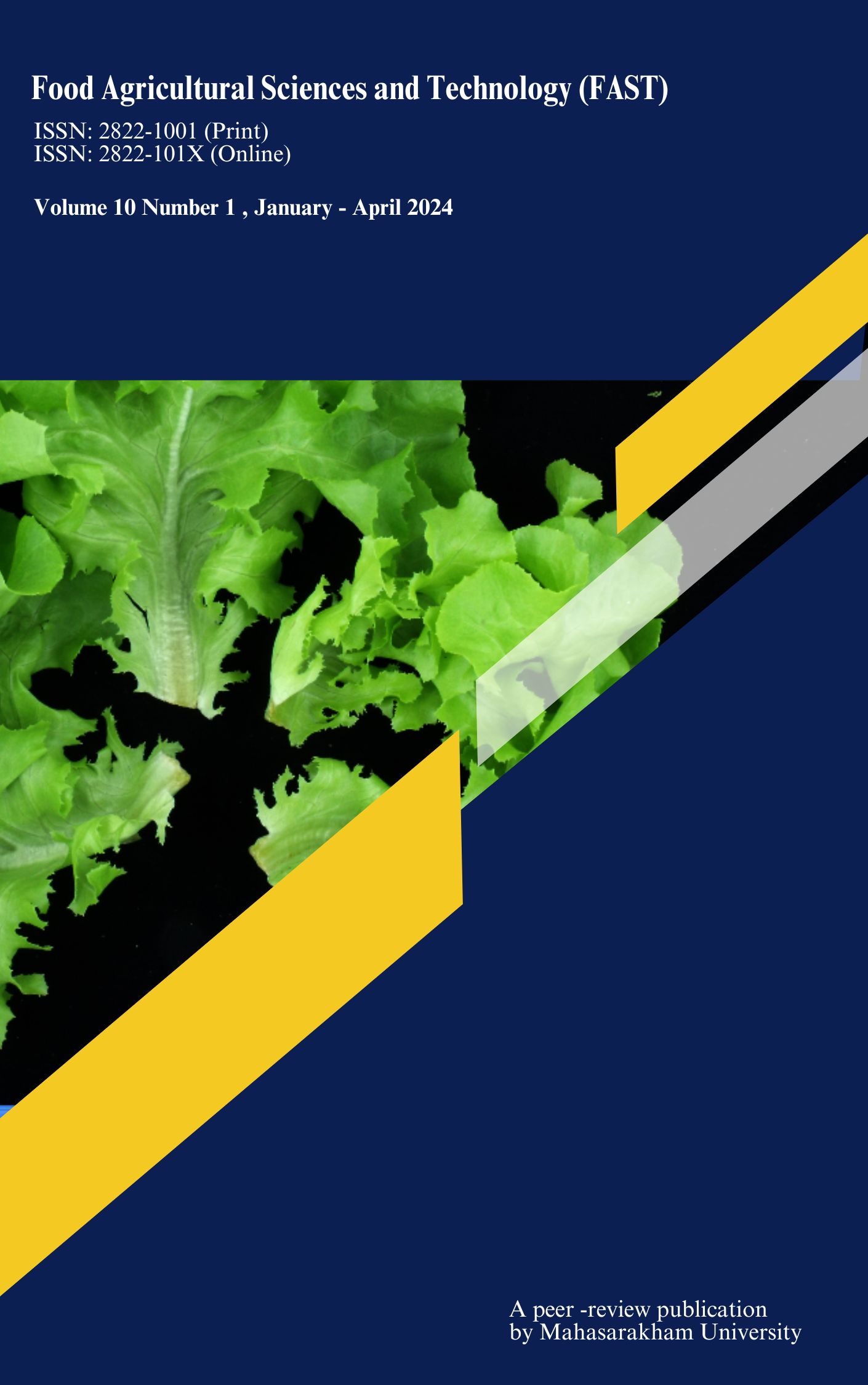Effect of roasting conditions on color, antioxidant, and sensory properties of lotus seed coffee as a coffee alternative
Keywords:
Coffee alternative, lotus seed, antioxidant activitiesAbstract
This research explored lotus seeds as coffee alternative, aiming to investigate the effect of different roasting conditions on color properties, roasting level, antioxidant capacity, and sensory attributes. Dried and ground lotus seeds were roasted at various temperatures ranging from 110°C to 160°C for 5, 10, and 15 minutes. The results indicated that increasing roasting time and temperature led to a rise in lightness, yellowness, and redness (represented by L*, a*, and b* values) as well as the browning index. The ground lotus seeds roasted at 110–120°C were categorized as light to light-medium roasting exhibited the lowest total phenolic content (TPC) when compared to those roasted at 130°C (58.51 ± 0.66–69.78±0.69) and 140°C for 5 minutes (58.11 ± 0.99) (medium roasting). However, dark-roasted lotus seeds (140°C for 10 and 15 minutes) showed a lower TPC compared to the sample roasted at 140°C for 5 minutes. The DPPH assay showed a pattern of increased antioxidant capacity at 130°C for 15 minutes (69.78 ± 0.69), followed by a decrease with rising roasting temperature and time at 140°C for 5 minutes (35.98 ± 0.88). Only the samples roasted at 140°C received 80% acceptability on a 9-point hedonic scale. Among the various roasting durations at 140°C, the sample roasted for 5 minutes exhibited the highest antioxidant properties in terms of TPC and DPPH. Therefore, lotus seed samples roasted at 140°C for 5 minutes to a medium-dark level demonstrated acceptable sensory characteristics and significant antioxidant properties.
References
Ali, G. (2023). Hulled roasted barley drink as an alternative to coffee: Sensory evaluation, chemical composition and caffeine content, antioxidant activity and economic evaluation. Alexandria Science Exchange Journal, 44(4), 505-514. https://doi.org/10.21608/ASEJAIQJSAE.2023.318725
Antonietti, S., Silva, A. M., Simões, C., Almeida, D., Félix, L. M., Papetti, A., & Nunes, F. M. (2022). Chemical composition and potential biological activity of melanoidins from instant soluble coffee and instant soluble barley: A comparative study. Frontiers in Nutrition, 9, 825584. https://doi.org/10.3389/fnut.2022.825584.
Baydalinova, L., & Melnikova, V. (2016). The use of Jerusalem artichoke for coffee substitute manufacture. Vestnik Mezhdunarodnoi akademii kholoda, 1, 13-18 https://doi.org/10.21603/2308-4057-2021-1-69-78
Bekedam, E. K., De Laat, M. P., Schols, H. A., Van Boekel, M. A., & Smit, G. (2007). Arabinogalactan proteins are incorporated in negatively charged coffee brew melanoidins. Journal of Agricultural and Food Chemistry, 55(3), 761-768. https://doi.org/10.1021/jf063010d
Bobková, A., Hudáček, M., Jakabová, S., Belej, Ľ., Capcarová, M., Čurlej, J., & Demianová, A. (2020). The effect of roasting on the total polyphenols and antioxidant activity of coffee. Journal of Environmental Science and Health, Part B, 55(5), 495-500. https://doi.org/10.1080/03601234.2020.1724660
Bolek, S., & Ozdemir, M. (2017). Optimization of roasting conditions of Pistacia terebinthus in a fluidized bed roaster. LWT, 80, 67-75. https://doi.org/https://doi.org/10.1016/j.lwt.2017.02.007
Bolek, S. (2022). Effects of roasting on bioavailability and bioactivities of Vigna angularis and potential of coffee‐like beverage. Journal of Food Science, 87(3), 911-918. https://doi.org/10.1111/1750-3841.16048
Brand-Williams, W., Cuvelier, M. E., & Berset, C. (1995). Use of a free radical method to evaluate antioxidant activity. LWT - Food Science and Technology, 28(1), 25-30. https://doi.org/https://doi.org/ 10.1016/S0023-6438(95)80008-5
Carvalho, D. O., Gonçalves, L. M., & Guido, L. F. (2016). Overall antioxidant properties of malt and how they are influenced by the individual constituents of barley and the malting process. Comprehensive Reviews in Food Science and Food Safety, 15(5), 927-943. https://doi.org/https://doi.org/10.1111/1541-4337.12218
Chen, P., Cui, H., Feng, L., Yu, J., Hayat, K., Jia, C., Zhang, X., & Ho, C.-T. (2022). Effect of the c-ring structure of flavonoids on the yield of adducts formed by the linkage of the active site at the a-ring and Amadori rearrangement products during the maillard intermediate preparation. Journal of Agricultural and Food Chemistry, 70(10), 3280-3288. https://doi.org/10.1021/acs.jafc.1c07521
Díaz-rojas, L., Galán-bernal, N., Forero, D. P., Linares, E. L., Marín-loaiza, J. C., & Osorio, C. (2019). Characterization of odour-active volátiles and sensory analyses of roasted oak (Quercus humboldtii Bonpl.) acorns, a coffee substitute. Vitae, 26(1), 44-50. https://doi.org/10.17533/udea.vitae.v26n1a05
Echavarría, A. P., Pagán, J., & Ibarz, A. (2012). Melanoidins formed by Maillard reaction in food and their biological activity. Food Engineering Reviews, 4, 203-223. https://doi.org/10.1007/s12393-012-9057-9
Feng, C.-Y., Li, S.-S., Yin, D.-D., Zhang, H.-J., Tian, D.-K., Wu, Q., Wang, L.-J., Su, S., & Wang, L.-S. (2016). Rapid determination of flavonoids in plumules of sacred lotus cultivars and assessment of their antioxidant activities. Industrial Crops and Products, 87, 96-104. https://doi.org/https://doi.org/10.1016/j.indcrop.2016.04.030
Fikry, M., Yusof, Y. A., Al-Awaadh, A. M., Rahman, R. A., Chin, N. L., Mousa, E., & Chang, L. S. (2019). Effect of the roasting conditions on the physicochemical, quality and sensory attributes of coffee-like powder and brew from defatted palm date seeds. Foods, 8(2), 61.
Geel, L., Kinnear, M., & de Kock, H. L. (2005). Relating consumer preferences to sensory attributes of instant coffee. Food Quality and Preference, 16(3), 237-244. https://doi.org/https://doi.org/10.1016/j.foodqual.2004.04.014
Gorjanović, S., Komes, D., Laličić-Petronijević, J., Pastor, F. T., Belščak-Cvitanović, A., Veljović, M., Pezo, L., & Sužnjević, D. Ž. (2017). Antioxidant efficiency of polyphenols from coffee and coffee substitutes-electrochemical versus spectrophotometric approach. Journal of Food Science and Technology, 54(8), 2324-2331. https://doi.org/10.1007/s13197-017-2672-y
Hofmann, T. (1998). Studies on melanoidin-type colorants generated from the Maillard reaction of protein-bound lysine and furan-2-carboxaldehyde–chemical characterisation of a red coloured domaine. Zeitschrift für Lebensmitteluntersuchung und-Forschung A, 206, 251-258. https://doi.org/10.1007/s002170050253
Indrayan, A. K., Sharma, S., Durgapal, D., Kumar, N., & Kumar, M. (2005). Determination of nutritive value and analysis of mineral elements for some medicinally valued plants from Uttaranchal. Current Science, 89(7), 1252-1255.
Jiang, X., Wang, J., Ou, Y., & Zheng, B. (2021). Effect of chlorogenic acid on the structural properties and digestibility of lotus seed starch during microwave gelatinization. International Journal of Biological Macromolecules, 191, 474-482. https://doi.org/10.1016/j.ijbiomac.2021.09.102
Komes, D., Bušić, A., Vojvodić, A., Belščak-Cvitanović, A., & Hruškar, M. (2015). Antioxidative potential of different coffee substitute brews affected by milk addition. European Food Research and Technology, 241(1), 115-125. https://doi.org/10.1007/s00217-015-2440-z
Kroh, L. W. (1994). Caramelisation in food and beverages. Food Chemistry, 51(4), 373-379.
Lemos, M. R. B., de Almeida Siqueira, E. M., Arruda, S. F., & Zambiazi, R. C. (2012). The effect of roasting on the phenolic compounds and antioxidant potential of baru nuts [Dipteryx alata Vog.]. Food Research International, 48(2), 592-597. https://doi.org/10.1016/j.foodres.2012.05.027
Marcolino, E., Salavarria, D., da Silva, L. G. M., Almeida, A., Oliveira da Silva, F. M., Ribeiro, C., & Dias, J. (2023). Valorization of baobab seeds (Adansonia digitata) as a coffee-like beverage: evaluation of roasting time on bioactive compounds. Journal of Food Science and Technology, 1-7. https://doi.org/10.1007/s13197-023-05873-2
Majcher, M. A., Klensporf-Pawlik, D., Dziadas, M., & Jeleń, H. H. (2013). Identification of aroma active compounds of cereal coffee brew and its roasted ingredients. Journal of Agricultural and Food Chemistry, 61(11), 2648-2654. https://doi.org/10.1021/jf304651b
Mostafa, M. M., Ali, E., Gamal, M., & Farag, M. A. (2021). How do coffee substitutes compare to coffee? A comprehensive review of its quality characteristics, sensory characters, phytochemicals, health benefits and safety. Food Bioscience, 43, 101290. https://doi.org/https://doi.org/10.1016/j.fbio.2021.101290
Müller, R., & Rappert, S. (2010). Pyrazines: occurrence, formation and biodegradation. Applied Microbiology and Biotechnology, 85, 1315-1320. https://doi.org/10.1007/s00253-009-2362-4
Murthy, K. V., Ravi, R., Bhat, K. K., & Raghavarao, K. S. M. S. (2008). Studies on roasting of wheat using fluidized bed roaster. Journal of Food Engineering, 89(3), 336-342. https://doi.org/https://doi.org/10.1016/j.jfoodeng.2008.05.014
Nunes, F. M., & Coimbra, M. A. (2010). Role of hydroxycinnamates in coffee melanoidin formation. Phytochemistry Reviews, 9, 171-185. https://doi.org/10.1007/s11101-009-9151-7
Pinsuwan, A., Suwonsichon, S., Chompreeda, P., & Prinyawiwatkul, W. (2022). Sensory drivers of consumer acceptance, purchase intent and emotions toward brewed black coffee. Foods, 11(2), 180. https://doi.org/10.3390/foods11020180
Punia, S., Dhull, S. B., Kunner, P., & Rohilla, S. (2020). Effect of γ-radiation on physico-chemical, morphological and thermal characteristics of lotus seed (Nelumbo nucifera) starch. International Journal of Biological Macromolecules, 157, 584-590. https://doi.org/https://doi.org/10.1016/j.ijbiomac.2020.04.181
Rojas, S., M., Chejne, F., Ciro, H., & Montoya, J. (2020). Roasting impact on the chemical and physical structure of Criollo cocoa variety (Theobroma cacao L). Journal of Food Process Engineering, 43(6), e13400. https://doi.org/10.1111/jfpe.13400
Samsonowicz, M., Regulska, E., Karpowicz, D., & Leśniewska, B. (2019). Antioxidant properties of coffee substitutes rich in polyphenols and minerals. Food Chemistry, 278, 101-109. https://doi.org/10.1016/j.foodchem.2018.11.057
Şahin, H., Topuz, A., Pischetsrieder, M., & Özdemir, F. (2009). Effect of roasting process on phenolic, antioxidant and browning properties of carob powder. European Food Research and Technology, 230, 155-161. https://doi.org/10.1007/s00217-009-1152-7
Tamanna, N., & Mahmood, N. (2015). Food processing and maillard reaction products: effect on human health and nutrition. International journal of food science, 2015, Article ID 526762. https://doi.org/10.1155/2015/526762
Torma, A., Orbán, C., Bodor, Z., & Benedek, C. (2019). Evaluation of sensory and antioxidant properties of commercial coffee substitutes. Acta Alimentaria, 48(3), 297-305. https://doi.org/10.1556/066.2019.48.3.3
Tu, Y., Yan, S., & Li, J. (2020). Impact of harvesting time on the chemical composition and quality of fresh lotus seeds. Horticulture, Environment, and Biotechnology, 61, 735-744. https://doi.org/10.1007/s13580-020-00233-x
Wojtowicz, E., Zawirska-Wojtasiak, R., Przygoński, K., & Mildner-Szkudlarz, S. (2015). Bioactive β-carbolines norharman and harman in traditional and novel raw materials for chicory coffee. Food Chemistry, 175, 280-283. https://doi.org/https://doi.org/10.1016/j.foodchem.2014.11.143
Youn, K. S., & Chung, H. S. (2012). Optimization of the roasting temperature and time for preparation of coffee-like maize beverage using the response surface methodology. LWT-Food Science and Technology, 46(1), 305-310. https://doi.org/10.1016/j.lwt.2011.09.014
Zawirska-Wojtasiak, R., Wojtowicz, E., Przygoński, K., & Olkowicz, M. (2014). Chlorogenic acid in raw materials for the production of chicory coffee. Journal of the Science of Food and Agriculture, 94(10), 2118-2123. https://doi.org/https://doi.org/10.1002/jsfa.6532
Zhu, M., Liu, T., Zhang, C., & Guo, M. (2017). Flavonoids of lotus (Nelumbo nucifera) seed embryos and their antioxidant potential. Journal of Food Science, 82(8), 1834-1841. https://doi.org/10.1111/1750-3841.13784
Żyżelewicz, D., Krysiak, W., Nebesny, E., & Budryn, G. (2014). Application of various methods for determination of the color of cocoa beans roasted under variable process parameters. European Food Research and Technology, 238, 549-563. https://doi.org/10.1007/s00217-013-2123-6
Żyżelewicz, D., Krysiak, W., Oracz, J., Sosnowska, D., Budryn, G., & Nebesny, E. (2016). The influence of the roasting process conditions on the polyphenol content in cocoa beans, nibs and chocolates. Food Research International, 89, 918-929. https://doi.org/10.1016/j.foodres.2016.03.026
Downloads
Published
How to Cite
Issue
Section
License
Copyright (c) 2023 Food Agricultural Sciences and Technology

This work is licensed under a Creative Commons Attribution-NoDerivatives 4.0 International License.








